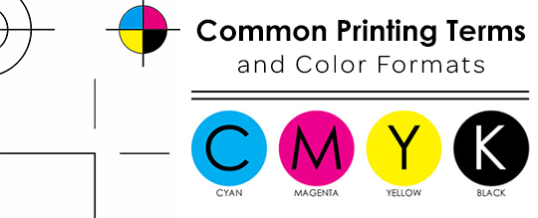Commonly Used Printing Terms
 The print business
The print business
uses a large number of designations that might not be familiar
to you.
Here, we’ve listed some commonly used printing terms to make the print buying experience easier.
Binding
The fastening of papers to create a brochure or book. The most common binding styles are saddle stitch, perfect binding, side-stitch, case or edition, and mechanical.
Bleed
A printed color or image that extends past the trimmed edges of a page, usually 1/8th of an inch.
Clipping path
A vector-based outline used to “clip” or silhouette an image from its surroundings so only the desired part will print.
Creep
The phenomenon of the middle pages of a folded signature extending slightly beyond the
outside pages.
Crop
The blocking out of unwanted parts of an image to fit a layout space or deleting portions that are not relevant.
Crossover
An image or type that continues across a spread of a brochure, book, or magazine to another page.
CMYK
Acronym for the ink colors used in four-color process printing. The letters stand for cyan, magenta, yellow, and key (black). Commonly referred to as process colors.
DPI (Dots Per Inch)
In offset printing, dpi is the number of dots that fit horizontally and vertically into a one-inch measure, therefore, the higher the dpi, the sharper the printed image.
EPS (Encapsulated PostScript)
File format for images or graphics.
Finish
This generally refers to the surface characteristics of paper – such as gloss, matte, silk, velvet, satin, and dull, but this term can also refer to the finishing process that occurs during post-press operations, which includes trimming, scoring, folding, and binding.
Font
A typeface family that includes all letters and numbers in the same style.
Form
Pages of a book or brochure that are printed on the same sheet of paper as it passes through the press, but once the sheet is folded and trimmed, the form becomes a “signature”.
Four Color Process
Method of printing using cyan, magenta, yellow, and black (CMYK) inks to simulate full color images, known as full color printing and process printing.
FPO (For Position Only)
Usually a low resolution image (72 or 100 dpi) file is used only to indicate placement and size in a comp and a high resolution image will replace it before printing.
Hard copy
A paper printout at 100% size of digital files. It is usually generated on a desktop laser or inkjet printer.
Hi-Res
High-resolution image, usually 300 to 350 dpi.
Knockout
An area of background color that has been masked out (knocked out) by a foreground object and therefore does not print.
Low-Res
Low-resolution image, such as 72 or 100 dpi.
Markup
Instructions written on a hard copy printout.
Match color
A custom-blended ink color that matches a specified color in a color system such as Pantone®, Toyo®, or TruMatch®. It is not built from a combination of CMYK.
Overprint
Printing one ink over another, such as printing type over a screen tint.
PDF (Portable Document Format)
Adobe® Systems file format to facilitate cross-platform viewing of documents in their original form.
Pre-press
Ripping files, setup, and other work performed by the printer, separator, or service bureau in preparation for printing.
Proof
Print made from digital files to check for errors and flaws, predict results on press, and record how a printing job is intended to appear when finished.
RGB Red, Green, and Blue
The additive primaries used in monitors. They are not printing colors.
RIP (Raster Image Processor)
This device is designed to interpret PostScript files and create a document suitable for printing.
Source File
The original graphic file.
Spot Color or Varnish
Specific color or varnish that is applied only to portions of a sheet.
TIF or TIFF (Tagged Image File Format)
Raster file format used for image placement in page layout programs. TIFs can sometimes be tinted and modified in a page layout program where EPS images cannot.
Trim size
The size of the printed piece in its finished form.
UV coating
Liquid applied to a coated sheet, then bonded and cured with ultraviolet light. UV coating creates an extremely glossy look.
Vector graphics
Graphics that use mathematical calculations to describe lines and curves. The most commonly used vector program is Illustrator®.